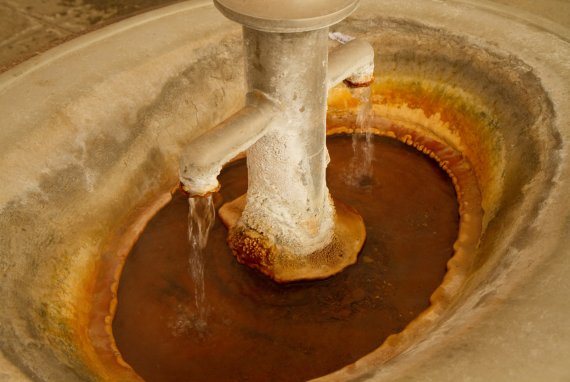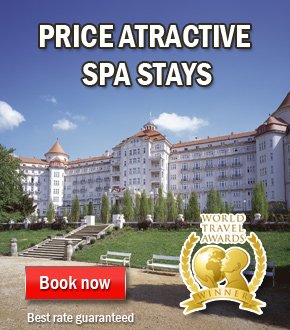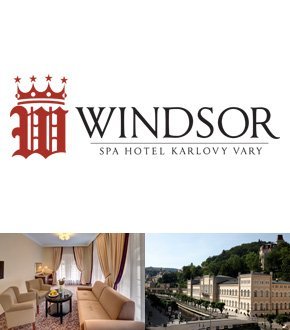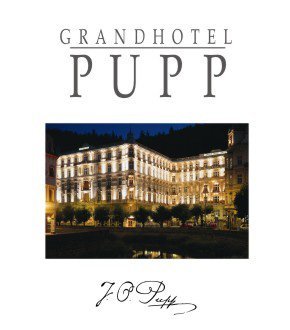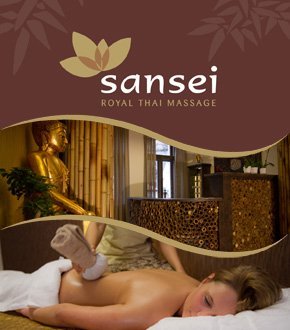I am here Introduction > Trips > Walks in Karlovy Vary > Following the footsteps of Karlovy Vary springs
Following the footsteps of Karlovy Vary springs
Set out to Karlovy Vary colonnades in the footsteps of springs around the many historically significant sites. If you will not get to see these Karlovy Vary gems, you have actually not been in Karlovy Vary. It would be something like being in Paris without seeing the Eiffel Tower.
We will start the walk perhaps unexpectedly at that unofficial source, the Becherovka. Yes, our journey starts at the TGM Avenue at the Jan Becher Museum. The museum is located in the former factory where this herbal liqueur used to be produced. After the tour of the cellar, seeing the exhibited items and viewing a short film you can continue further. But if you want to taste Becherovka in the place where it is made now, do it carefully. You still have a number of kilometres ahead of you.
| JAN BECHER MUSEUM | Opening Hours | Admission CZK |
|---|---|---|
| T.G.M. 57, Karlovy Vary Reservations: Tel.: +420 359 578 142 E-mail: vstupenky@jan‑becher.com Web: www.becherovka.cz |
Mon–Sun 9:00 AM – 5:00 PM |
Adults: 120,– (price includes tasting of 3 products) Students and Seniors: 60,– (price includes tasting of 3 products). Children under 18 years: 30,– (without tasting). Family ticket: 240,– (2 adults + 2 children under 18 years) |
Go through the walkway above the museum to Dr. David Becher Street and walk up the hill. Continue straight to the Krále Jiřího Street. The street is filled with luxury villas mostly from the 19th century. Some of them function as luxury hotels.
Almost at the end of the street (behind the corner), on the left side, you will see a structure that does not fit among the residential villas very much. It is the St. Peter and St. Paul Orthodox Church, which was built in the Byzantine style. Opposite the church is a park with a small lake, where you can refresh yourself in the restaurant Little Versailles. A few meters behind the church, turn left at the end of the street. When you have walked a few steps and you have reached the statue of Karl Marx, turn left again. Go down through the Sadová Street to the Dvořák Park, which lies on the left bank of the river Teplá.
You are standing next to the building of the Military Spa Institute. Next to this sanatorium there is the first of the colonnades, the Park Colonnade. The first springs are coming up in its vicinity.
The Park Colonnade
(1880, Fellner and Helmer)
Should you want to try this or any other springs, you should not combine their water with alcohol or nicotine. You should only taste the water, do not drink too much of it, it should be used exclusively on the doctor's prescription. Mineral water is consumed from special cups. These are available in every smoke shop or in a shop with souvenirs.
| Spring | Description |
|---|---|
| The Snake Spring 30 °C |
The spa guests have been encountering this spring since the year 2001, it contains fewer minerals than other springs, but it has larger quantities of CO2.The spring comes out from the snake's mouth right in the Park Colonnade. |
| The Park Spring 47,4 °C |
This spring came up in the mid-19th century during the excavation of the foundation pit for the Military Spa Institute. It was originally called the Imperial Spring. The spring comes up in the area of the Military Spa Institute, right next to the colonnade. It is open every day from 6:00 AM to 6:30 PM. |
From the Park Colonnade go upstream to the next colonnade. On the right side you will pass the Spa III building. This spa is routinely the scene of classical music concerts. Between the Spa III and the Mill Colonnade you will find a bower with the Freedom Spring.
| Quelle | Description |
|---|---|
| The Freedom Spring 62 °C |
The spring which was discovered during the construction of the Spa III bears this name since the end of the World War II. First it was called the Spa Spring and during the Austro-Hungarian Empire it was called the Franz Joseph I Spring. |
The Mill Colonnade
(1871–1881, Josef Zítek)
The Mill Colonnade was built in the 19th century. It covers five springs. The Colonnade is proud of its 124 Corinthian columns, orchestra stage for the spa orchestra and interesting allegorical scenes.
| Spring | Description |
|---|---|
| The Rock Spring 53 °C |
This spring was coming out from the river Teplá until the year 1845. After the modification of terrain its water was brought to the area of today's Mill Colonnade. |
| The Libuše Spring 62 °C |
Originally known as the Elizabeth Rose Spring. The spring was formed by connecting four small springs. |
| The Prince Wenceslas I 65 °C The Prince Wenceslas II 58 °C |
Water from this spring was used to produce the Karlsbad (Karlovy Vary) medicinal salt. It has been said that at the end of the 18th century its yield and strength could be measured with the Hot Spring. The Prince Wenceslas Spring is directed to two spring vases. The Spring I comes out directly in the colonnade, the Spring II comes out in front of the colonnade, across from the orchestra stage. |
| The Mill Spring 56 °C |
This spring has been used for spa treatments already since the 16th century. Originally it was mainly used for bathing. It used to be possible to buy the water from this popular spring nearly in all Czech pharmacies. |
| The Rusalka Spring 60 °C |
From the 16th century until the year 1945 it was called the New Spring. At its time, the water emanating from it was more popular than that of the Mill Spring. The spring had its own New Spring Colonnade, which was later rebuilt and named as the Mill Colonnade. |
Once you have enjoyed the beauty of the largest Karlovy Vary colonnade, continue upstream. Behind the curve in the road you will see three colonnades. Cross over to the left side of the street and get to know the largest spring in Karlovy Vary. Coming across the place is always impressive even for the ones who already know it.
The Hot Spring Colonnade
(1969–1975, Prof. J. Votruba)
Apart from the Hot Spring, the hall also contains a restaurant, toilets, a few souvenir shops and other places of interest The hall is open daily from 6:00 AM to 7:00 PM. The underground section of the colonnade is open to an interesting excursion tour of the Hot Spring Underground.
The Church of St. Mary Magdalene is located above the Hot Spring Colonnade. It was built on the site of the former Gothic church, which was reduced to ashes. The author of this Baroque building is the well-known architect Kilián Ignác Dientzenhofer. Apart from the temple, tourists can also visit the underground crypt. The tour can be arranged in the main lobby of the Hot Spring Colonnade.
| Spring | Description |
|---|---|
| The Hot Spring 72 °C |
This geyser produces on average 2.000 litres of mineral water every minute. Today it is the only spring used by bathing. But the Hot Spring is also used for drinking cures. The colonnade area has a total of 5 bowls with spring water at the temperatures of 72, 57 and 41 °C. Due to the pressure, the column of hot spring water can spurt up to the height of 12 meters. |
From the church, walk down around the Hot Spring Colonnade and cross over to the Market Colonnade.
The Market Colonnade
(1883, Fellner and Helmer)
The Market Colonnade was built in the Swiss style during the 80s of the 19th century as a temporary shelter for the springs. The today's structure copies the original building. It was completed in 1991. The Market Spring and the Charles IV Spring come up inside its premises. The Zawojski Art Nouveau building is located opposite the colonnade.
| Spring | Beschreibung |
|---|---|
| The Market Spring 62°C |
Since its discovery in 1838, the spring disappeared and reappeared several times. There were several boreholes drilled, thanks to which the today’s doctors are able to prescribe its water for drinking cures. |
| The Charles IV Spring 64°C |
The curative abilities of this spring may have contributed to the decision of the Emperor Charles IV to build a spa here. The discovery of Karlsbad (Karlovy Vary) is attested by the relief placed above the spring. |
The Castle Colonnade
(1911–1913, Friedrich Ohmann)
The Market Colonnade was built in the Swiss style during the 80s of the 19th century as a temporary shelter for the springs. The today's structure copies the original building. It was completed in 1991. The Market Spring and the Charles IV Spring come up inside its premises. The Zawojski Art Nouveau building is located opposite the colonnade.
| Name | Description |
|---|---|
| The Lower Castle Spring 55 °C The Upper Castle Spring 50 °C |
Actually this is only one source which is led to two spring vases. However, due to the greater altitude of the upper vents and the laws of physics, the Upper Castle Spring has a different temperature and CO2 content when compared to the Lower Spring. |
Above the Market Colonnade stands a Gothic Castle Tower, which is what remains today from the original Charles IV Castle. The Castle burned down at the beginning of the 17th century. The tower was rebuilt in the Baroque style during the 18th century. It served for welcoming of important guests to the spa.
Now you can embark for the last spring. But if you are tired, relax and take a seat in some café or restaurant. There are plenty of them around. Indeed, part of the spa treatment is a slow walk, mental balance, peace and long strolls. The second part of your stroll is still waiting for you, so take it easy and slow down.
While you are behind the Hot Spring, cross the river and go to the funicular station at the Square (Divadelní) Theatre. The funicular runs four times every hour. You will pass through the rock mass towards the Hotel Imperial, which is one of the landmarks of the town. The trip takes 2 minutes. Take a walk to the hotel and see its beautiful surroundings. After that, go behind the hotel and walk down on a meandering path back to the river Teplá. The descent on these serpentines is quite challenging. If you don’t feel up to it, go around the tennis courts to the Libušina municipal bus stop No. 11 and ride down to the Richmond by bus. Continue on the Slovenská Street against the flow until you get to the Parkhotel Richmond.
On the way to the Stephanie Spring you will see the Art Gallery on your right-hand side.
| The Karlovy Vary Art Gallery | Opening Hours |
|---|---|
| Goethova stezka 6 Karlovy Vary Tel.: +420 353 224 387 Fax: +420 353 224 388 info@galeriekvary.cz www.galeriekvary.cz |
Tue–Sun 10:00 AM – 5:00 PM The gallery regularly organizes cultural and educational events for the public. In these cases, the operating time may vary. |
Admission to all exhibitions is FREE every first Wednesday of the month.
The bower at the Parkhotel Richmond
The bower with the Stephanie Spring can be found in a large park in front of the Parkhotel Richmond. It is open to the public without any restrictions.
| Name | Description |
|---|---|
| The Stephanie Spring 13 °C |
The spring was discovered in 1884 and thanks to its composition it became an important part of the drinking cures. But the spring was lost in the first half of the 20th century and it was not rediscovered until the year 1993. |
The Stephanie Spring was the last stop on our journey. In the park which surrounds it you will also see the Japanese stone garden, the statue of a deer and monuments to Beethoven and Mickiewicz. You can go back to the centre of the town by walking along the river, or you can take the bus No. 2 or 11 from the Richmond bus stop, around which you have passed on your way to the hotel.
Come to Karlovy Vary for treatment and discover the healing power of thermal springs.
Selection of spa programs »
Selection of wellness programs »
Choose from a wide selection of accommodation in Karlovy Vary »
Related links:
KARLOVY-VARY.CZ
Virtuální infocentrum Karlovy Vary
Habrová 1445
363 01 Ostrov
Tel.: +420 773 378 559
E-mail: info@karlovy-vary.cz



